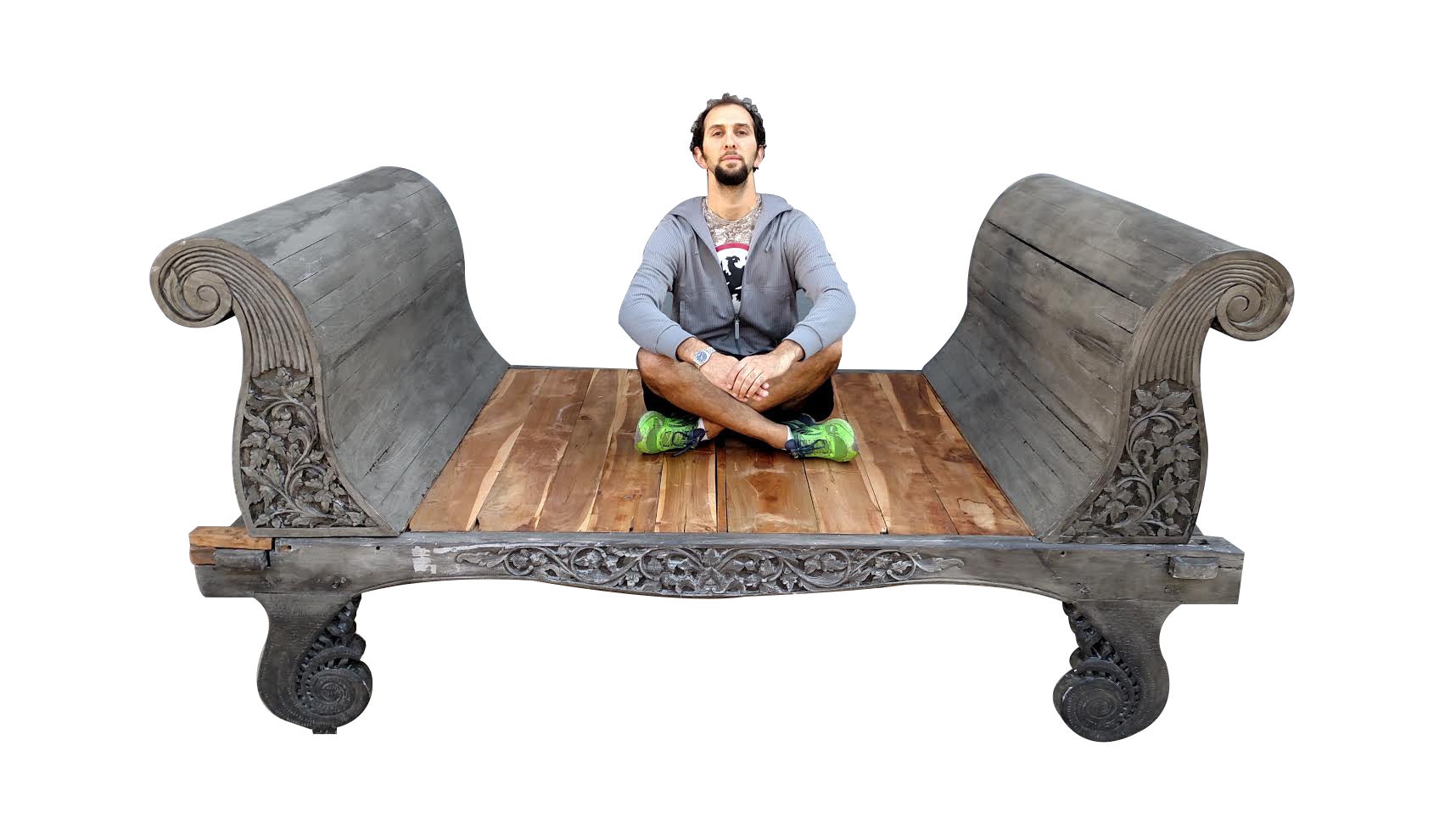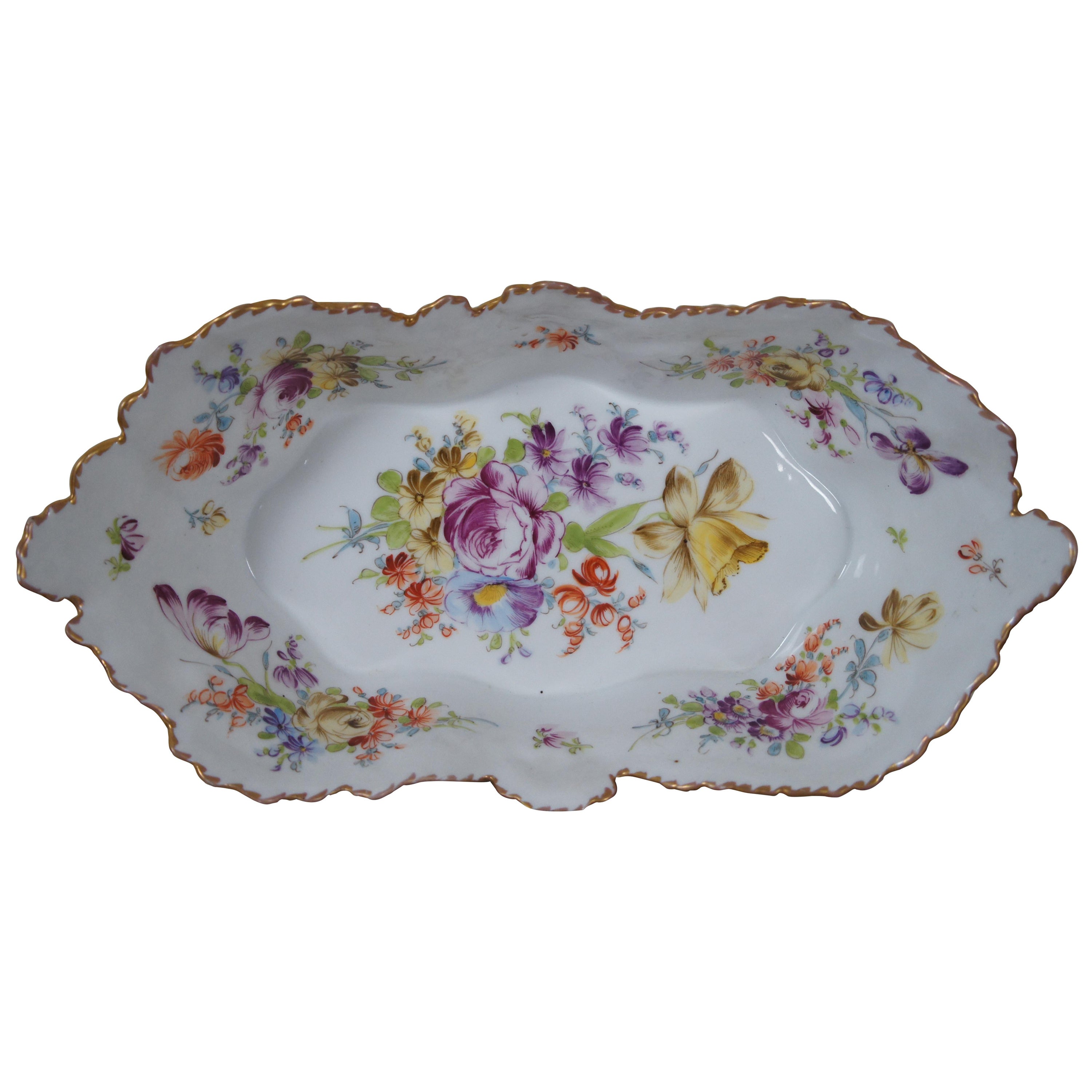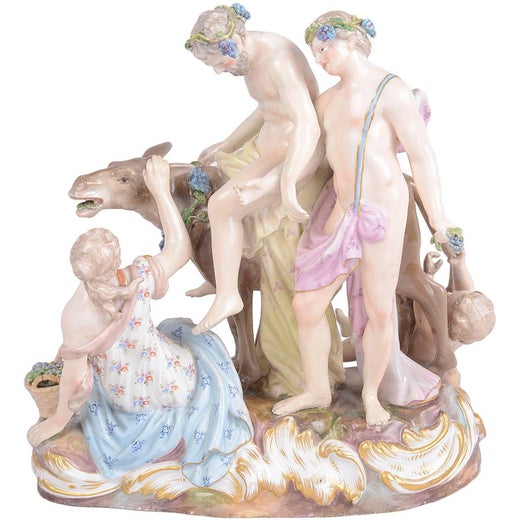Antique German Dresden Meissen Gilded Grape Leaves Centerpiece Compote 14"
About the Item
- Creator:Meissen Porcelain (Manufacturer)
- Dimensions:Height: 3 in (7.62 cm)Width: 10.75 in (27.31 cm)Depth: 14 in (35.56 cm)
- Materials and Techniques:
- Period:
- Date of Manufacture:1815-1860
- Condition:Wear consistent with age and use. Good Overall - Gentle wear.
- Seller Location:Dayton, OH
- Reference Number:
Meissen Porcelain
Meissen Porcelain (Staatliche Porzellan-Manufaktur Meissen) is one of the preeminent porcelain factories in Europe and was the first to produce true porcelain outside of Asia. It was established in 1710 under the auspices of King Augustus II “the Strong” of Saxony-Poland (1670–1733), a keen collector of Asian ceramics, particularly Ming porcelain.
In pursuing his passion, which he termed his “maladie de porcelaine,” Augustus spent vast sums, amassing some 20,000 pieces of Japanese and Chinese ceramics. These, along with examples of early Meissen, comprise the Porzellansammlung, or porcelain collection, of the Zwinger Palace, in Dresden.
The king was determined, however, to free the European market from its dependence on Asian imports and to give European artisans the freedom to create their own porcelain designs. To this end, he charged the scientist Ehrenfried Walther von Tschirnhaus and aspiring alchemist Johann Friedrich Böttger with the task of using local materials to produce true, hard-paste porcelain (as opposed to the soft-paste variety European ceramists in the Netherlands, Germany, France, Italy and Spain had been producing since the late Renaissance). In 1709, the pair succeeded in doing just that, employing kaolin, or “china clay.” A year later, the Meissen factory was born.
In its first decades, Meissen mostly looked to Asian models, producing wares based on Japanese Kakiemon ceramics and pieces with Chinese-inflected decorations called chinoiserie. During the 1720s its painters drew inspiration from the works of Watteau, and the scenes of courtly life, fruits and flowers that adorned fashionable textiles and wallpaper. It was in this period that Meissen introduced its famous cobalt-blue crossed swords logo — derived from the arms of the Elector of Saxony as Arch-Marshal of the Holy Roman Empire — to distinguish its products from those of competing factories that were beginning to spring up around Europe.
By the 1730s, Meissen’s modelers and decorators had mastered the style of Asian ceramics, and Augustus encouraged them to develop a new, original aesthetic. The factory’s director, Count Heinrich von Brühl, used Johann Wilhelm Weinmann’s botanical drawings as the basis for a new line of wares with European-style surface decoration. The Blue Onion pattern (Zwiebelmuster), first produced in 1739, melded Asian and European influences, closely following patterns used in Chinese underglaze-blue porcelain, but replacing exotic flora and fruits with Western varieties (likely peaches and pomegranates, not onions) along with peonies and asters.
During the same period, head modeler Joachim Kändler (1706–75) began crafting delicate porcelain figures derived from the Italian commedia dell’arte. Often used as centerpieces on banquet tables and decorated to reflect the latest fashions in courtly dress for men and women, these figurines were popular in their day, and are still considered among Meissen’s most iconic creations. Kändler also created the Swan Service, which, with its complex low-relief surface design and minimal decoration is considered a masterpiece of Baroque ceramics.
The rise of Neoclassicism in the latter half of the 18th century forced Meissen to change artistic direction and begin producing monumental vases, clocks, chandeliers and candelabra. In the 20th century, Meissen added to its 18th-century repertoire decidedly modern designs, including ones in the Art Nouveau style. The 1920s saw the introduction of numerous animal figures, such as the popular sea otter (Fischotter), which graced an East German postage stamp in the 1960s. Starting in 1933, artistic freedom was limited at the factory under the Nazi regime, and after World War II, when the region became part of East Germany, it struggled to reconcile its elite past with the values of the Communist government. In 1969, however, new artistic director Karl Petermann reintroduced the early designs and fostered a new degree of artistic license. Meissen became one of the few companies to prosper in East Germany.
Owned by the State of Saxony since reunification, in 1990, Meissen continues to produce its classic designs together with new ones developed collaboratively with artists from all over the world. In addition, through its artCAMPUS program, the factory has invited distinguished ceramic artists, such as Chris Antemann and Arlene Shechet, to work in its studios in collaboration with its skilled modelers and painters. The resulting works of contemporary sculpture are inspired by Meissen’s rich and complex legacy.
Find a collection of authentic Meissen Porcelain on 1stDibs.

- ShippingRetrieving quote...Ships From: Dayton, OH
- Return PolicyA return for this item may be initiated within 2 days of delivery.
- Antique Meissen Cobalt Gilded Grape Leaves Reticulated Centerpiece Compote 13"By Meissen PorcelainLocated in Dayton, OHAntique German Dresden Meissen porcelain footed cabinet plate / centerpiece bowl / serving platter / compote featuring scalloped oval form with low relief...Category
Early 20th Century Platters and Serveware
MaterialsPorcelain
- Antique Dresden Meissen Cobalt Gilded Roses Reticulated Centerpiece Compote 14"By Meissen PorcelainLocated in Dayton, OHAntique German Meissen porcelain footed cabinet plate / centerpiece bowl / serving platter / compote featuring scalloped oval form with low relief reticul...Category
Antique Early 19th Century Platters and Serveware
MaterialsPorcelain
- Antique German Dresden Porcelain Gilded Floral Centerpiece Bowl Compote 12"Located in Dayton, OHAntique German Dresden crown H mark centerpiece bowl or serving compote. Made of porcelain featuring scalloped oval form with floral design and gold accents. Attributed to Adolf ...Category
Antique Late 19th Century Victorian Serving Bowls
MaterialsPorcelain
- Antique German Meissen Dresden Sprays Porcelain Floral Serving Spoon 8.5"By Meissen PorcelainLocated in Dayton, OHAntique German Meissen Dresden porcelain berry serving spoon featuring floral motif. DIMENSIONS 8.5" x 1.75" x 1.125" (Diameter x Height)Category
Early 20th Century Porcelain
MaterialsPorcelain
- 6 Antique German Dresden Meissen Klemm Carl Thieme Pitcher Tea Cups PlatesBy Meissen Porcelain, Klemm & Co., Dresden PorcelainLocated in Dayton, OHAntique lot includes creamer, demitasse cup, and two bone dishes by Dresden, one demitasse cup by Meissen, and one candlestick by Klemm. “The Sächsische Porzellan-Manufaktur Dresden GmbH (Saxon Porcelain Manufactory in Dresden Ltd), generally known in English as Dresden Porcelain, is a German company for the production of decorative and luxury porcelain. Founded in1872, it is located in Potschappel, a suburb of the town of Freital in the Sächsische Schweiz-Osterzgebirge district about 8 km (5 mi) southwest of Dresden, the capital of Saxony. Dresden Porcelain introduced its blue "SP Dresden" trademark in 1902.” "Meissen porcelain or Meissen china was the first European hard-paste porcelain. Early experiments were done in 1708 by Ehrenfried Walther von Tschirnhaus. After his death that October, Johann Friedrich Böttger continued von Tschirnhaus's work and brought this type of porcelain to the market, financed by Augustus the Strong, King of Poland and Elector of Saxony. The production of porcelain in the royal factory at Meissen, near Dresden, started in 1710 and attracted artists and artisans to establish, arguably, the most famous porcelain manufacturer known throughout the world. Its signature logo, the crossed swords, was introduced in 1720 to protect its production; the mark of the swords is reportedly one of the oldest trademarks in existence. Meissen remained the dominant European porcelain factory, and the leader of stylistic innovation, until somewhat overtaken by the new styles introduced by the French Sèvres factory in the 1760s, but has remained a leading factory to the present day. Since 1991, the manufactory has been operating as the Staatliche Porzellan-Manufaktur Meissen GmbH,[2] whose owner is the Free State of Saxony. The company is one of the world's leading porcelain manufacturers and one of the oldest and most internationally known German luxury brands." "Karl Richard Klemm founded a porcelain decorating studio in Striesen bei Dresden in 1869. The porcelain was obtained primarily from the Meissen factory itself, much of it being seconds. The decorating style of Richard Klemm closely matched that of the Meissen factories at that time. He often used a heavily applied style that focused on florals. In many instances, the porcelain pieces of Richard Klemm are emblazoned with a gold leaf at the base. This gold leaf was used to hide the marks made by the original manufacturer of the blanks that he used for decorating. Richard Klemm, along with Helena Wolfsohn, Karl Thiem, Ambrosius Lamm and Donath & Co., were among the most sought after porcelain decorating studios at this time. In the early 1880's Richard Klemm registered his mark, the "Klemm Dresden...Category
Early 20th Century Porcelain
MaterialsPorcelain
- Antique German Meissen Dresden Porcelain Snake Handle Mantel Urn Vase 12"By Meissen PorcelainLocated in Dayton, OH"Meissen porcelain or Meissen china was the first European hard-paste porcelain. Early experiments were done in 1708 by Ehrenfried Walther von Tschirnhaus. After his death that Octob...Category
20th Century Urns
MaterialsPorcelain
- Antique 800 Silver Gravy Boat, gilded, Germany, Dresden SchnaufferLocated in Berlin, DEAntique 800 Silver Gravy Boat, gilded, Germany, Dresden Schnauffer Half Moon & Crown inside gold Plated Weight: 355 gramsCategory
Antique 19th Century German Platters and Serveware
MaterialsGold, Silver
- Antique German Dresden Carl Thiem Reticulated Cake PlateBy Carl Thieme, Dresden PorcelainLocated in Frederick, MDThis beautiful antique porcelain cake plate is by Carl Thieme for Dresden China. The intricate reticulated cutouts at the handles are expertly done while the hand painted floral gard...Category
Antique Early 1900s German Platters and Serveware
MaterialsPorcelain
- German Porcelain Partial Dinner Service, Meissen, 19th CenturyBy Meissen PorcelainLocated in New York, NYComprising 18 soups, 18 dinner plates, one large fish platter, and one large meat platter, one covered vegetable tureen, two serving bowls.Category
Antique 19th Century German Dinner Plates
MaterialsPorcelain
- Antique Cherub Compote Dish, English, Decorative Putti, Grape Bowl, VictorianLocated in Hele, Devon, GBThis is an antique cherub compote dish. An English, ceramic decorative putti grape bowl, dating to the Victorian period, circa 1880. Of bold, cherubi...Category
Antique Late 19th Century British Victorian Platters and Serveware
MaterialsCeramic
- Antique Sheffield Reproduction Silver Plated Serving Tray with Grapes & LeavesLocated in Hamilton, OntarioThis antique serving tray was made by an unkwown maker and presumed to have originated from England and date to approximately 1920 and done in a Victorian style. The tray is done in silver plate and has applied grape and leaf decoration around the outer edges with ornate stylized scrollwork and flowers engraved on the top. The tray is clearly signed "Sheffield Reproduction...Category
Early 20th Century English Victorian Sheffield and Silverplate
MaterialsSilver Plate
- Antique Meissen Porcelain Neu Brandenstein Fish Platter & Strainer InsertBy Meissen Porcelain, Johann Joachim KaendlerLocated in Philadelphia, PAA fine Meissen porcelain fish tray with its rare strainer. By the Meissen Porcelain Manufactory. In the Neu Brandenstein Relief pattern. Or...Category
Early 20th Century German Rococo Platters and Serveware
MaterialsPorcelain






